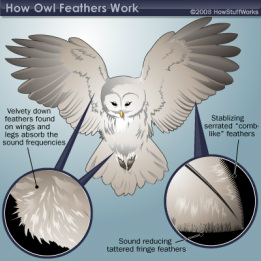Owls, the enigmatic raptors of the night, are nature’s quintessential predators. Their remarkable success stems from a suite of evolutionary adaptations specifically honed for nocturnal hunting. These adaptations, ranging from specialized feathers that enable silent flight to asymmetrical ears that pinpoint prey with uncanny accuracy, provide owls with an undeniable edge in the perpetual struggle for survival. Understanding these adaptations unveils the secrets behind their predatory prowess.
I. The Silent Assassin: Aerodynamic Adaptations for Flight
Owls are masters of stealth, capable of approaching prey with an ethereal silence that belies their size. This silent flight is attributable to several key morphological features. The leading edges of their flight feathers possess comb-like serrations, akin to fringes. These serrations disrupt the airflow, breaking down the turbulent eddies that generate the whooshing sound associated with typical avian flight. The trailing edges of the feathers are also fringed, further dampening sound. These adaptations collectively minimize the noise profile, allowing owls to detect prey before the prey detects them.
Furthermore, the velvety texture of owl feathers contributes to sound absorption. This unique texture dampens the sounds created by the owl’s own movements, ensuring that its approach remains imperceptible.
II. Auditory Acuity: Pinpointing Prey in the Dark
Many owl species exhibit extraordinary auditory adaptations that enable them to locate prey with exceptional precision, even in complete darkness. This ability relies on a phenomenon known as binaural hearing, but in owls, it is enhanced by asymmetrical ear placement. In many owl species, the ear openings are positioned at different heights on either side of the head. This asymmetry means that sounds reach each ear at slightly different times and with varying intensities.
The owl’s brain meticulously analyzes these subtle differences in arrival time and intensity to create a three-dimensional auditory map of its surroundings. This map allows the owl to pinpoint the exact location of a sound source with remarkable accuracy, even if the prey is hidden beneath snow or vegetation. Some species, like the Barn Owl, have facial discs that act as parabolic reflectors, further channeling sound into the ear openings and enhancing their auditory sensitivity. A cochlear disparity also exists within their inner ear. This increases their sensitivity to a broader range of frequencies that are common in the sounds produced by prey.
III. Visual Prowess: Seeing in the Shadows
While owls are renowned for their hearing, their vision is equally crucial for hunting in low-light conditions. Owls possess exceptionally large eyes relative to their body size. These large eyes gather more light, enhancing their visual acuity in dim environments. The eyes are tubular in shape, rather than spherical, which increases the focal length and magnifies the image projected onto the retina. This enhances their ability to discern details in low light.
The retina contains a high concentration of rod cells, which are photoreceptor cells specialized for detecting light intensity. This abundance of rod cells provides owls with excellent night vision. Cones, which are responsible for color vision, are present in lower numbers, indicating that owls likely have limited color perception. The tapetum lucidum, a reflective layer behind the retina, further enhances night vision by reflecting light back through the photoreceptor cells, giving the retina a second chance to absorb photons. This creates the characteristic “eyeshine” observed in owls at night.
Owls have limited eye movement within their sockets. However, this limitation is compensated for by their remarkable neck flexibility. They can rotate their heads up to 270 degrees, allowing them to scan their surroundings without moving their bodies. This extensive range of motion is facilitated by specialized adaptations in their neck vertebrae and blood vessels, preventing damage during extreme rotations.
IV. Talons and Beaks: The Tools of Predation
Once an owl has located its prey, it relies on its powerful talons and sharp beak to capture and subdue it. Owl talons are exceptionally strong and curved, providing a secure grip on their prey. The zygodactyl arrangement of their toes, with two toes pointing forward and two pointing backward, allows them to grasp prey with exceptional force. This grip is further enhanced by sharp, retractable talons that can pierce and hold even slippery prey.
The owl’s beak is short, strong, and sharply hooked, ideally suited for tearing flesh. Owls typically swallow small prey whole. Larger prey is dismembered using the beak and talons. Indigestible materials, such as bones, fur, and feathers, are regurgitated in the form of pellets. Analyzing these pellets can provide valuable insights into the owl’s diet and the local ecosystem.
V. Camouflage and Cryptic Behavior: Remaining Unseen
Many owl species exhibit cryptic coloration and patterns that allow them to blend seamlessly into their surroundings. Their plumage often mimics the bark of trees or the colors of the surrounding vegetation, making them virtually invisible to both prey and predators during daylight hours. This camouflage is complemented by their behavior. Owls are often inactive during the day, roosting in secluded locations to avoid detection. This combination of camouflage and cryptic behavior contributes to their success as ambush predators.
In conclusion, the evolutionary adaptations that have shaped owls into formidable predators are a testament to the power of natural selection. From their silent flight and acute hearing to their sharp talons and cryptic camouflage, every aspect of their morphology and behavior is finely tuned for hunting success. These adaptations not only ensure the owl’s survival but also play a crucial role in maintaining the balance of their respective ecosystems. The owl truly is the ultimate predator of the night.
